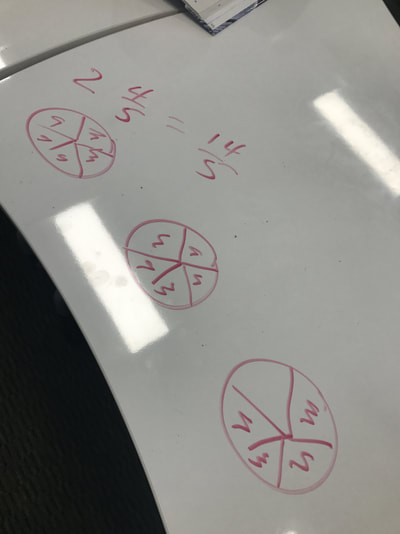|
The daily journal instructional guidance is now spreading to other content areas by the students in my Warrior Math Class. The next step is to get students to move from answering Domain of Knowledge (DOK) levels 1 & 2 to do more of DOK levels 3 & 4 thinking.
0 Comments
Accountability versus Learning
Co-Teaching works and "All Means All" students can learn with the right instructional methods done consistently. Every student needs to know what they are learning on a daily basis. But most importantly they need to know why they are learning and why it is important to them that they do well. One solution is to have students write on a daily basis in a journal but as a minimum to summarize what they have learned on a daily basis. Using the blended model approach we can enhance learning and share with other students. Students need to talk about the topic and this is so true in learning mathematics. Below is a daily post from one of the students in the Warrior Math Classroom. Interesting enough is my conversation with one of my new students just two weeks ago: I heard these common statements, "I'm not good at math", " I hate math", " Math sucks", and the list goes on and on. Below are the comments from that same student after two weeks in my Warrior Math classroom. There must be a why! Change begins with a why! I have a why and tomorrow my students must state his or her personal why! Because without the why nothing will happen! All Means All! Every student must be able to have access to learning the standards through the curriculum and the instructional methods. The below gallery are illustrations from the 2nd Period Warrior Math Classroom of Dr. Smith at Mountain View High School's "All Means All" Classroom for Common Core Mathematics.
#sanjacintodifference #warriormath
Home Task 1 - Students are asked to define recursive and explicit in their math journals (google docs). Task 2 - Students review content objectives to identify and write their language objective statements. Task 3 - Student discover new vocabulary words and place them in their math journal. Students identify words like function, exponential, linear, describe, representations, etc. Students are not starting to understand the importance of close reading in mathematics and the connections of vocabulary. They struggle to clarify their understanding to find the correct method and solutions. Everyday Warrior Math has a new adventure in Dr. Smith's classroom. Making math fun! Students reminded of their resources through Khan Academy, Learnbop assessments, and warriorcchsmath.weebly.com and this Warrior Blog #howtolearnmath, #warriormathblog, #sanjacintodifference One simple and often over-looked instructional strategy is a Math Journal. Warrior Math uses technology to do this. These Warrior students are AMAZING!  Today periods 1, 3, & 4 learn about recursive and explicit functions and how to write each using strategies of noting the differences to get the next one (recursive) and how to derive an equation to predict one in the future (explicit thinking). These are notes while working with one of my partner teacher's students showing that "All Means All" have the abilities to do Common Core mathematics at MVHS. MVHS teachers use research-based instructional strategies on a daily basis.
COLOSO Worksheet
Students are introduced to the lessons in Khan Academy. The sign-up information is below:
Use the following for Dr. Smith's Class Only!
The following gallery shows some of student's conceptual development about mathematics.
What Is Close Reading? #Closereading, #howtolearnmath, #sanjacintodifference Close reading is a purposeful, critical analysis of a text that focuses on significant details or patterns in order to develop a deep, precise understanding of the text’s form, craft, and meanings. It is a key requirement of the Common Core State Standards and directs the reader’s attention to the text itself. Close reading includes:
Top 20 Tier 2 Vocabulary Words for Math
|
Dr. Smith
|
||||||||||||
- Home
- CAASPP/SBAC PREP
- Orientation
- Dr. Smith MATH BLOG-2017-2018
- Privacy Policy
- Hour of Code
- Math Fun Night Videos
- CCHS MATH I
- CCHS MATH II
- CCHS MATH III
- Art of Math
- Parents
- RTI-FLOWMAP
- WOF-Good
- Hourofcode
- Content Objectives
- Common Core Standards
- Geometry Proofs
- MusicBlog
- CCHS Kahoot Challenge
- MATH & PEOPLE
- JavaScript Programming
- Star Wars
- Pearson Video Help
- Conference Presentations
- SBAC Practice #1
- SJAE Exit Survey
- CCEA MATH Resources
- CCHS MATH BLOG-2018-2019
- Brain-Based Research
- Stock Market Game





























 RSS Feed
RSS Feed
